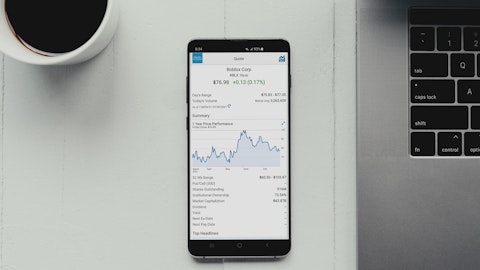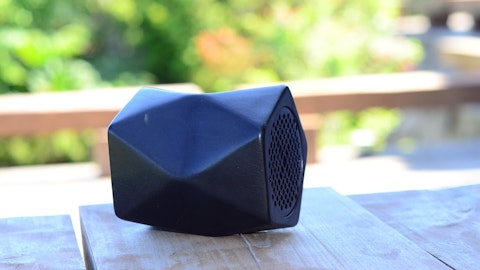Dolby Laboratories, Inc. (NYSE:DLB) Q2 2023 Earnings Call Transcript May 6, 2023
Operator: Ladies and gentlemen, thank you for standing by. Welcome to the Dolby Laboratories’ Conference Call discussing fiscal second quarter results. [Operator Instructions] As a reminder, this call is being recorded, Thursday, May 4, 2023. I would now like to turn the conference over to Maggie O’Donnell, Head of Investor Relations for Dolby Laboratories. Please go ahead, Maggie.
Maggie O’Donnell: Good afternoon, and welcome to Dolby Laboratories’ Second Quarter 2023 Earnings Conference Call. Joining me today are Kevin Yeaman, Dolby Laboratories’ CEO; and Robert Park, CFO. As a reminder, today’s discussion will include forward-looking statements, including our fiscal 2023 outlook and our assumptions underlying that outlook. These statements are subject to risks and uncertainties that may cause actual results to differ materially from statements made today, including, among other things, the impact of current macroeconomic issues, COVID-19, ongoing supply chain issues, inflation, changes in consumer spending and geopolitical instability on our business. A discussion of these and additional risks and uncertainties can be found in the earnings press release that we issued today under the section captioned Forward-looking Statements, as well as in the Risk Factors section of our most recent quarterly report on Form 10-Q.
Dolby assumes no obligation and does not intend to update any forward-looking statements made during this call as a result of new information or future events. During today’s call, we will discuss non-GAAP financial measures. A reconciliation between GAAP and non-GAAP financial measures is available in our earnings press release and in the Interactive Analyst Center on the Investor Relations section of our website. So with that introduction behind us, I will now turn the call over to Liz Krakowski [ph] who is going to be leading the conversation with Kevin.
Unidentified Company Representative: Thanks, Maggie. So Kevin, let’s get started. How are you thinking about the business in context of the macro environment?
Kevin Yeaman: Well, first and foremost, we’re going to continue to focus on what we and totally can control. We continue to execute well against each of our growth areas. There do continue to be questions about the macro environment. What I can say with confidence is that there has never been greater demand for entertainment content. There’s never been greater demand for content to be more engaging, and our consumers and partners want high-quality immersive experiences. This is our passion at Dolby. We have a proven track record of being able to adapt to a world of change and focus on the pursuit of those inspiring experiences. And that’s where we’re going to stay focused.
Unidentified Company Representative: So Kevin, we’re halfway through the year, how is the business progressing?
Kevin Yeaman: Well, the first half of the year has come in stronger than we expected, and we continue to see some transactions closing earlier in the year. And as it relates to our foundational audio technologies and the underlying business trends, the first quarter, you’ll remember, we saw TVs come in a little bit stronger than we had expected. In the second quarter, we saw PCs, DMAs, sound bars come in a little lighter than we had expected. But for the year overall, we see things playing out within the range of what we expected. Our foundational audio technologies, importantly, continue to be essential to the way entertainment content is delivered. It’s true that these areas are more sensitive to the macro environment.
We continue to expect that when the economy stabilizes, these areas will return to growth. For Dolby Atmos, Dolby Vision and imaging patents, we see all the signs that give us confidence that we can double these revenues in the next three to five years. And we’re on track to hit our growth target of 15% to 25% this year. And we expect to do this by continuing to focus on expanding our ecosystems around movies and TV, music and automotive and user-generated content.
Unidentified Company Representative: You just mentioned that you’re seeing signs that give you confidence that you can achieve your long-term goals with Dolby Atmos and Dolby Vision. Can you talk about what you’re seeing?
Kevin Yeaman: Yes, sure. So Dolby Atmos, Dolby Vision and imaging patents grew 30% last year. And one of the largest contributors to that growth was Dolby Atmos and Dolby Vision and our movies and TV ecosystem. And we continue to expect that to be a big driver this year. The movies and TV ecosystem drives growth across TVs, set-top boxes, smart speakers. It also drives revenue across each of our end markets, whether it’s PCs or mobile devices. Growing ecosystems at Dolby means being a part of more and more of the content that people love and then becoming a part of all the ways that people experience that content. In the case of movies and TV, Dolby Vision and Dolby Atmos are included on roughly a quarter of 4K TVs, which is a significant position for consumers to enjoy that experience, but also leaves significant opportunity for growth.
So, we’re focused on driving deeper adoption into TV lineups with our existing partners. We talked about this last quarter with partners like TCL, Hisense, and others announcing their lineup at CES. We’re also focused on increasing our presence with regional streaming partners and local OEMs, which addresses a large part of the market. And so for example, we had some good wins this quarter in India. Disney Star and JioCinema announced that all of their 2023 Indian Premier League Cricket matches will be available in Dolby Atmos, and we also had a number of local OEM wins. Going beyond movies and TV, we’re really excited about the progress we’re making within our user-generated content and music ecosystems. While they’re both at early stages, they’re shaping up to be significant growth contributors going forward.
So I want to start with user-generated content because we had some great wins this quarter. OPPO became our newest partner for Dolby Vision Capture, launching their flagship phone. Xiaomi now has half a dozen Dolby Vision Capture phone models in China. And this quarter, they started shipping phones to India, Southeast Asia, Europe and the Middle East. Vivo began shipping Dolby Vision Capture phones in China. And Weibo, one of China’s largest social media platforms, now supports Dolby Vision and Dolby Atmos, joining the likes of WeChat, Bilibili and QQ.
Unidentified Company Representative: So what’s driving the demand in the user-generated content ecosystem?
Kevin Yeaman: Well, consumers are passionate about the experiences that they can create and share with Dolby Vision. And that’s our focus to make the content that people care most about more engaging. And as we’ve talked about before, the camera is a major reason people upgrade their phones. And so as we progress throughout the year, we expect more phones to be available with Dolby Vision capture and playback and more services with the ability to capture and share that content.

Photo bz tech daily on Unsplash
Unidentified Company Representative: I personally really enjoy having Dolby Vision capture on my phone and sharing memories and pictures and things, especially my two little kids. So Kevin, let’s move on to Music. What are you seeing there?
Kevin Yeaman: We continue to see tremendous momentum across content, streaming services and devices, particularly in wireless speakers and automotive. This quarter, Sonos launched their premium smart speaker, the Sonos Era 300 with Dolby Atmos. And this product comes at a time when studios, streaming service and artists are all coming together to embrace the Dolby Atmos music experience. As it relates to automotive, in just under two years, we’ve gone from announcing our first partner to today having cars in market from multiple manufacturers, including Mercedes, who is releasing additional models this year, and Volvo whose cars will be available early next year. Just a few weeks ago, Guangzhou Automobile Group, which is the fourth largest auto manufacturer in China, announced that they’re launching Dolby Atmos in their new sports sedan.
So we continue to see strong demand across the automotive market, and we’re working to bring more partners on board during the rest of this year. On the services side, Amazon began streaming to a wider set of devices, including more wireless speakers, sound bars and DMAs. NetEase Music is one of the largest music streaming services in China, and they began streaming to more devices, including mobile, PC and automobile. It’s great to see these services are continuing to add more and more content. Apple Music this quarter launched Apple Music Classical, which is a new classical music app where listeners can enjoy thousands of recordings in Dolby Atmos. Every day, there’s more and more content available. Top artists across genres and generations are creating in Dolby Atmos.
And whether that’s the Billboard top 100 artists or a favorite song from a special moment in your life, you are more likely than ever to find your favorite songs in Dolby Atmos. Beyond music, you can enjoy audio books and podcasts in Dolby Atmos. Audible is now streaming a number of their most popular audio books and podcasts in Dolby Atmos. They joined Wondery and regional services in India, South Korea and the Middle East. So, more and more ways to enjoy Dolby, very relevant experience in the car and on the go. And we’re excited to continue to make stories more immersive and more experiential. So, as it relates to continued growth in Dolby Atmos, Dolby Vision and imaging patents, we continue to make progress across each of these focused areas, movies and TV, automotive and music, user-generated content.
And beyond that, we remain focused on bringing Dolby to a far wider range of use cases with Dolby.io. We continue to see strong interest from developers who are creating the next generation of online immersive experiences. What we bring is unparalleled audio quality and ultra-low latency for large-scale environments, and we continue to see an increase in the number of developers and customers that are using Dolby.io.
Unidentified Company Representative: So Kevin, before I move on to Robert, any final thoughts?
Kevin Yeaman: Well, as long as people want to watch movies and TV, listen to music, or connected with each other through social media apps and gaming. There continues to be a big opportunity for Dolby to make a difference. We’re confident about our growth opportunities, and we’re making progress across each of our ecosystems and focus areas. We’re coming at this from a position of strength, with a strong business model, strong profitability and strong cash flow. We’re going to continue to be agile and responding to changes in the market, and we’re focused on the opportunities to bring Dolby Atmos and Dolby Vision to all the ways that people experience their content.
Unidentified Company Representative: Thanks for that context, Kevin. Okay. So let’s turn it over to Robert. Robert, can you start us off with some highlights for the quarter?
Robert Park: Yes, thanks, Liz. Yes, before we get into the details, I want to point out a couple of things. First, total revenue of $376 million was higher than the guidance we provided last quarter. We saw transactions close earlier than anticipated, and we benefited from higher imaging patent royalty revenue in our broadcast and mobile markets, partially offset by lower unit shipments than expected in our PC and consumer electronic markets. Second, we continue to operate in an uncertain environment. That said, based on what we’re seeing today, we continue to expect revenue growth. Our revenue outlook range for the year is $1.27 billion to $1.33 billion or 1% to 6% year-over-year growth. With that as a backdrop, let’s get into the Q2 details.
Q2 revenue of $376 million was up 12% year-over-year, with growth in mobile and broadcast, primarily from Dolby Atmos, Dolby Vision and imaging patents, higher box office positively impacting our Dolby Cinema and higher products and services revenue. This was partially offset by lower revenue in PC and CE markets, primarily from lower unit shipments. Q2 revenue was comprised of $352 million in licensing revenue and $24 million in products and services revenue. Now let’s talk about licensing revenue by end market. As a reminder, our licensing business is based on unit shipments. We also have transactions that reflect revenue from units shipped in prior periods, which we call recoveries, and minimum volume commitments where all or a portion of the revenue for a given period is recognized upfront.
These transactions are all related to unit shipments. Broadcast represented about 37% of total licensing in Q2 2023, up $24 million or 23% on a year-over-year basis, driven primarily by minimum volume commitments and imaging patents and Dolby Atmos. Mobile represented about 26% of total licensing in Q2 2023, up $27 million or 41% on a year-over-year basis, driven by minimum volume commitments, primarily in Dolby Atmos, Dolby Vision and imaging patents. Consumer Electronics represented about 12% of total licensing in Q2 of 2023, down $15 million or 28% on a year-over-year basis, driven by lower unit shipments in the first half, primarily in DMAs and sound bars related to foundational audio technologies. PC represented about 12% of total licensing in Q2 2023, down $14 million or 25% on a year-over-year basis, driven by lower unit shipments in the first half, primarily related to foundational audio technologies.
Other markets represented about 13% of total licensing in Q2 of 2023, up $15 million or 48% on a year-over-year basis, driven primarily by adoption of Dolby Atmos and Auto, higher box office for Dolby Cinema and higher unit shipments in gaming. Beyond licensing, our products and services revenue were $24 million in Q2 2023, up 18% on a year-over-year basis. The year-over-year increase was driven primarily by higher cinema product sales. We also saw growth in Dolby IO. Let’s turn to expenses and margins. Total non-GAAP gross margin in the second quarter was 89% compared to 90% in the second quarter of fiscal year 2022. Non-GAAP operating expenses in the second quarter were $195 million compared to $187 million in the second quarter of fiscal year 2022.
The increase was driven primarily by timing of marketing program spend. Non-GAAP operating income for Q2 was $141 million or 38% of revenue compared to 34% of revenue in Q2 of last year. Non-GAAP income tax in Q2 was 18% compared to 17% in last year’s Q2. Net income on a non-GAAP basis in the second quarter was $123 million or $1.26 per diluted share compared to $94 million or $0.92 per diluted share in Q2 of fiscal year 2022. During the quarter, we generated $105 million in cash from operations compared to $63 million generated in last year’s second quarter. We ended the second quarter with approximately $916 million in cash and investments. During the second quarter, we bought back about 630,000 shares of our common stock and ended the quarter with $262 million of stock repurchase authorization available going forward.
We also announced today a cash dividend of $0.27 per share. The dividend will be payable on May 23, 2023, to shareholders of record on May 16, 2023. Also, our patent pool administrator, Via, completed a small acquisition after the close of the quarter. The financial results of the acquired company are not expected to be material and are included in our guidance.
Unidentified Company Representative: With that, Robert, let’s get into guidance.
Robert Park: Great. We continue to operate in a challenging and uncertain environment. For fiscal year 2023, we expect that our revenue from foundation audio technologies will decline low single digits year-over-year, reflecting lower unit shipments, particularly in PC, TV, CE and mobile, consistent with what we’ve said previously. We are still targeting 15% to 25% growth in Dolby Vision, Dolby Atmos and imaging patents, driven by growth in broadcast, mobile and other markets. We assume this will more than offset the declines in foundational audio that we are expecting. With these assumptions, our full year 2023 revenue is expected to range from $1.27 billion to $1.33 billion. Within this, we anticipate license revenue to range from $1.17 billion to $1.22 billion, with growth in mobile, broadcast and other markets outpacing the decline in PC and CE.
Products and services revenue is expected to range from $100 million to $110 million. Non-GAAP gross margin is estimated to be roughly 88%. We still expect that non-GAAP operating expenses will increase roughly 2% compared to prior year and expect operating margins of roughly 30% on a non-GAAP basis for the year. We will continue to be disciplined with our spend, review our resource envelope and allocation on a regular basis. We anticipate non-GAAP earnings per share of $3.15 to $3.65. In terms of the full year split, we still expect that revenue in the second half will be lower than revenue in the first half at a similar split to what we saw last year. Let’s move on to guidance for the third quarter. Q3 revenue is expected to range from $285 million to $315 million.
Within that, licensing revenue is estimated to range from $260 million to $285 million, while products and services is projected to range from $25 million to $30 million. Compared to Q3 of last year, we expect growth in Dolby Atmos, Dolby Vision and imaging patents, particularly in broadcast, mobile and other markets, to more than offset lower revenue from foundational audio technologies driven by lower unit shipment estimates at PC and timing of committed volume transactions in mobile. Non-GAAP gross margin is estimated to be 86% to 87%. Operating expenses in Q3 on a non-GAAP basis are estimated to range from $195 million to $205 million. Our effective tax rate for Q3 is projected to range from 19% to 21% on a non-GAAP basis. We estimate that non-GAAP Q3 diluted earnings per share could range from $0.47 to $0.62.
We are pleased with the start to the year. While the macro environment remains uncertain, we are making progress on our long-term growth opportunities. We continue to believe the fundamentals of Dolby’s durable operating model, balance sheet and cash flows remain strong. Now let’s open it up for questions.
Unidentified Company Representative: All right. Thanks, Robert. Operator, I think, we’re ready to open up the queue for questions.
See also 20 Best Gourmet Coffee Brands in the US and 20 Most Valuable Smartphone Companies in the World.
Q&A Session
Follow Dolby Laboratories Inc. (NYSE:DLB)
Follow Dolby Laboratories Inc. (NYSE:DLB)
Operator: Thank you. [Operator Instructions] Your first question comes from the line of Steven Frankel with Rosenblatt.
Operator: We’ll take our next question from Paul Chung with JPMorgan.
Operator: We’ll take our next question from Ralph Schackart with William Blair.
Operator: We’ll take our next question from James Goss with Barrington Research.
Operator: And that concludes the question-and-answer session. I would like to turn the call back over to Maggie O’Donnell for closing remarks.
Maggie O’Donnell: Thank you, everybody, for joining us today. Have a great afternoon.
Kevin Yeaman: Thank you.
Operator: And that does conclude today’s presentation. Thank you for your participation. And you may now disconnect.





